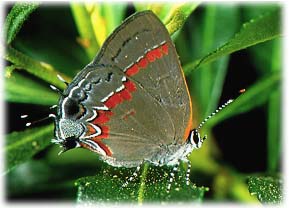

Easily identified by the bright reddish stripes on the underside of the hindwings, the red-banded hairstreak is a common resident of the southeastern U.S. It is often seen in large numbers at small-flowered plants, and is a frequent garden visitor. Easy to approach and observe, the red-banded hairstreak slowly moves its hindwings up and down while feeding or at rest. This common behavior, typical of most hairstreaks, draws a predator's attention toward the antennae-like tails and away from the butterfly's true head.
Adult females deposit their tiny cream colored eggs singly on dead leaves beneath wax myrtle and sumac bushes. Upon hatching, the small larvae crawl up into the bushes and feed on young leaves.